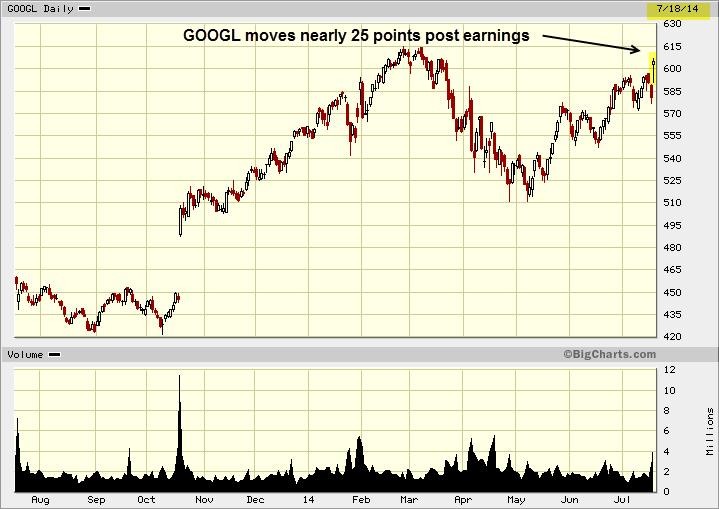Using Options to Predict an Earnings Move
Post on: 1 Июль, 2015 No Comment

A look at the options markets ahead of earnings can clue you in to a big move
Using Options to Predict an Earnings Move
Ahead of Google Inc.s (NASDAQ: GOOG ) earnings report on Thursday, I tweeted that the options marts priced in about a 5% move after hours. The company reported after the bell, and as luck would have it, the stock gapped up about 5%. And by Friday, the stock was actually up 10%.
I received kudos from fellow traders, and while I always appreciate a pat on the back, the fact is I wasnt attempting to predict what GOOG would do. Rather, I simply took a glance at the options board and reported what the markets themselves expected.
You see, traders bid up options ahead of planned news events like earnings announcements. The expectation is that once the news comes out, the stock will gap up or down, while options volatility will cave in. If you make an educated guess as to where option volatility will go after the news, you can readily calculate a breakeven magnitude the stock will have to gap such that the move up or down in stock price will offset the assured gap down in options volatility.
In other words, lets say stock XYZ trades at $100, and the near-month $95-$105 strangle trades for $5. If XYZ does nothing after earnings, options volatility will collapse, and that strangle might drop from $5 to $2. So the question is how far would XYZ have to gap to keep that strangle trading about $5?
I havent plugged in volatility assumptions or time left until expiration, so for ease of example, lets say it has to move up or down $8. That means your breakeven move after earnings is about 8%.
Google reported with only one trading day remaining before expiration. So you really didnt have to make much of a guess as to where volatility would go Friday. The options were all going to parity. All you really needed to do in this case was eyeball the at-the-money (ATM) straddle and the nearby strangles. And the dollar premiums in GOOG suggested the market expected a roughly 5% move.
This calculation only speaks to magnitude, not direction.
I am not a big believer in reading too much into call and put interest. Why? Well, suppose you see call buying. Is it smart money you should follow, or contrary sentiment you should fade? Theres really no way to know, which is why I would refrain from overanalyzing it.
Heres a very simple rule: Stocks generally dont reverse their trend on an earnings reaction. If its strong going in, more often than not its strong going out. So why bother with this exercise?

Well, perhaps it puts an earnings bid-up in terms that help you identify whether you want to position for it.
For example, if you saw GOOG priced in a 5% move, but personally expect it to move more than that, look for options to buy. If you thought that was high, look for options to sell.
It also helps to know which side has gotten caught. If the market priced in 10% and GOOG moved 10%, you would have a bevy of option traders with neither big gains nor losses, and ergo, not much expectation that they influence the stock in any way.
But if GOOG prices in 5% and moves 10%, option shorts on balance have gotten squeezed. And on the margins, we would expect them to chase stock to cover their losses. In other words, they can help a stock move in the direction it is already moving. Its tough to quantify, but I suspect that this is what took GOOG further than it might have ordinarily moved.
Follow Adam Warner on Twitter @agwarner .














